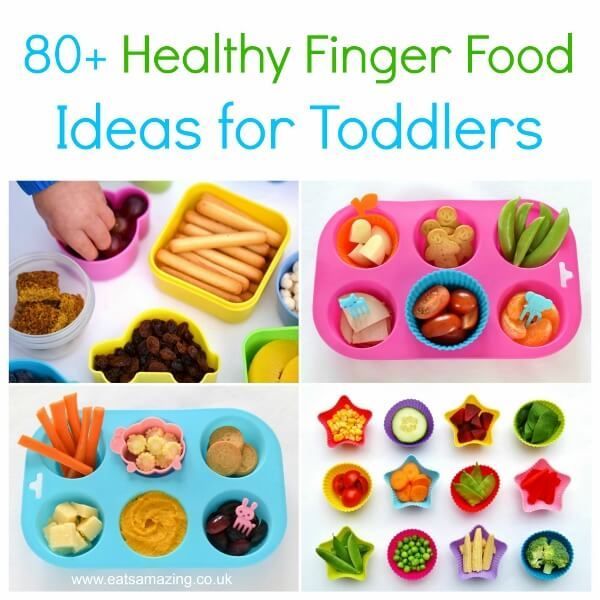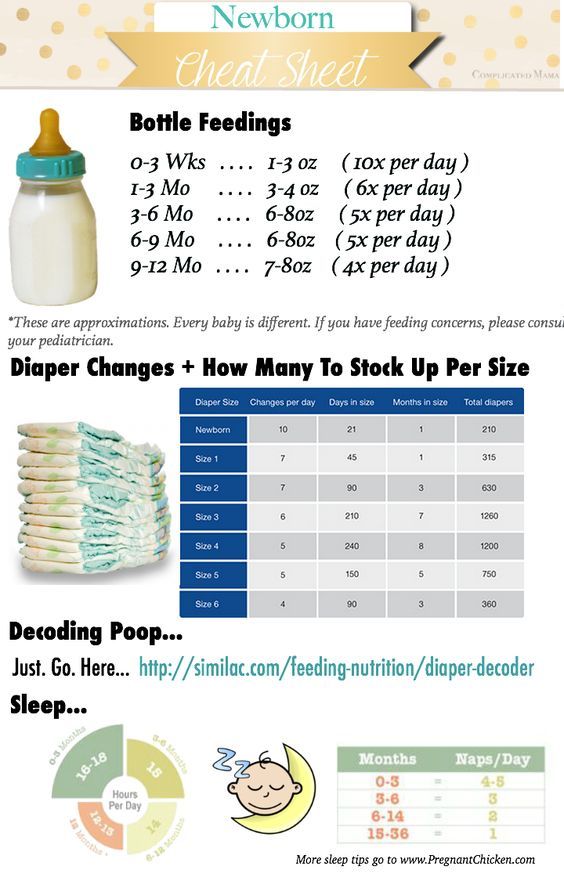Meat based baby food
Beech-Nut® beef & beef broth Stage 1 Baby Food
back
3.9 (24 Reviews)
This puree of beef and beef broth is a savory food that helps baby get protein. It has a smooth texture that’s easy to eat for baby as a great first step in learning to eat solid foods. Our stage 1 beef & beef broth is made with beef and beef broth; no added flavorings (no onion or garlic added) or artificial preservatives. Many parents tell us this blend is a favorite first food for babies who are starting solids. All Beech-Nut® baby food jars are vacuum-sealed for freshness. This jar can be stored in the refrigerator for up to 2 days after opening.
- Single, 2.5 oz Jar
- Stage 1: for babies 4 months and up
- Real beef and beef broth
- Adds protein to baby’s diet
- No added seasonings
- Caution: do not microwave jar; contents may splatter, causing burns
WIC™ Eligible: In AK, AL, AR, AZ, CA, CO, CT, DC, FL, GA, HI, IA, ID, IL, IN, KS, KY, LA, MA, MD, ME, MI, MN, MO, MS, MT, NC, ND, NE, NH, NJ, NM, NV, NY, OH, OK, OR, PA, PR, RI, SC, SD, TN, TX, UT, VA, VT, WA, WI, WV, WY
Included Inside
Beef
Broth
Ingredients: Beef, beef broth.
For the most accurate and up-to-date product information, please always refer to the label on the package itself.
Overall:
3.9 (24 Reviews)
-
Great for Cats prone to UTI
Baxter
My 8 yr male cat had a bladder blockage and two UTIs- he is on a high moisture raw food diet, but still needs more fluids. He won't drink plain water, broths, or goat milk, so I had to figure something out fast! I read about a cat owner giving her cats Beech Nut beef & beef broth because this brand doesn't add any flavoring or seasonings. I give him 1 teaspoon of food plus 2 tablespoons of purified water before each meal (morning and evening). His lab markers for hydration the past year are great! He used to have the Turkey & Turkey broth- but a test showed he's allergic to turkey. I am so grateful that Beech Nut has this product! It is a game changer!
-
good
mister kitty
our cat has allergies to most things they put in cat food, beechnut is what it says it is.
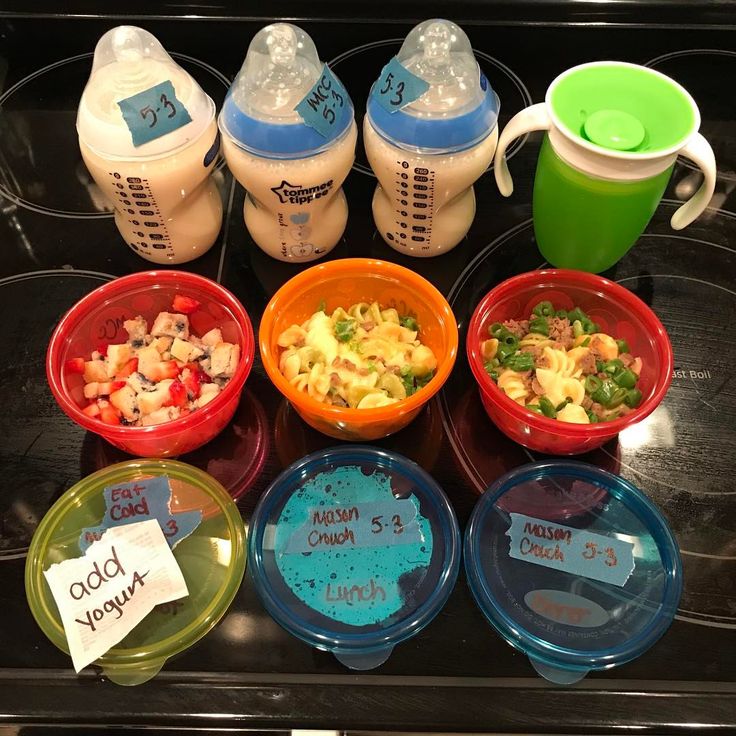 Gerber adds lemon to there baby food which is toxic to cats. Our cat loves the beef flavor the best
Gerber adds lemon to there baby food which is toxic to cats. Our cat loves the beef flavor the best -
Well loved by my mice
I offer my mice a variety of foods including a sort of milkshake made with baby food. The chicken, beef, and peach are their favorites.
-
What is in the beef broth? list all ingredients
Looking for answers
I just bought this since Ferber is out of stock, yet it inly lists 2 ingredients beef snd beef broth. This is misleading because the beef broth can include any ingredients they want. Seems like illegal labeling in my opinion.
Response from Beech-Nut®:
Thank you for bringing this to our attention. We will be sure to pass this feedback along to our team. If you have any further questions, feel free to call us at 800-233-2468 or email us at [email protected] Thanks!
-
Save my cats life!
808Vee808
Our beloved super senior 19 year old was recently diagnosed with hyperthyroidism a little over a month ago.
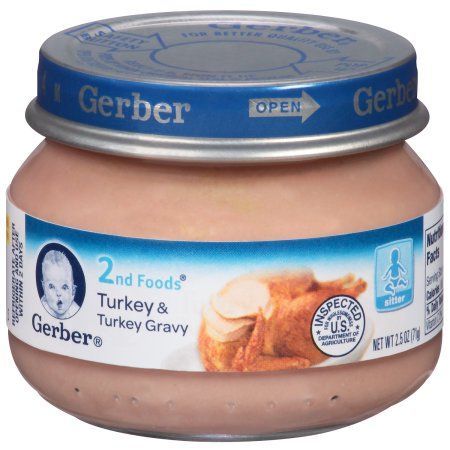 The veterinarian recommended euthanasia. I “told them” give me an appetite stimulant. I was determined that this was not a death sentence. Elderly humans live long lives with chronic disease. Why can’t cats. I began offering half a teaspoon as not to waste. Then fed a tablespoon every two hours. While doing this teaching myself about proper nutrition for cats. We changed the overall diet to raw with pre-mix for a complete meal and now use this baby food for snacks “with HT medication dose” and giving probiotics. What a life saver this product has been!!! Big mahalo from Hawaii❤️
The veterinarian recommended euthanasia. I “told them” give me an appetite stimulant. I was determined that this was not a death sentence. Elderly humans live long lives with chronic disease. Why can’t cats. I began offering half a teaspoon as not to waste. Then fed a tablespoon every two hours. While doing this teaching myself about proper nutrition for cats. We changed the overall diet to raw with pre-mix for a complete meal and now use this baby food for snacks “with HT medication dose” and giving probiotics. What a life saver this product has been!!! Big mahalo from Hawaii❤️ -
No additives!
A FAE
I started using meat baby food for sick cats because if they won't eat anything they will eat meat baby food. I have been giving my Bengal Cat Beef and it is his favorite treat. That "other" company now puts corn starch and lemon juice in theirs so I can not/will not buy that one again. BEECH-NUT IS THE VERY BEST!
-
My cat loves it!
Jennay
My cat got diagnosed with IBD the poor baby.
 I had to think quick and ditch the kibble with the help of a group who is dealing with the same thing. I was recommended baby food for him and omg he LOVES it. I will make it a balanced diet. He has a lot of gi issues and I was told that this is very easy for them to digest. Wow. Why do they even bother making that trash cat commercial kibble. Y'all cat owners should just buy this and balance the meat or get them on raw asap! My cat is MY BABY.
I had to think quick and ditch the kibble with the help of a group who is dealing with the same thing. I was recommended baby food for him and omg he LOVES it. I will make it a balanced diet. He has a lot of gi issues and I was told that this is very easy for them to digest. Wow. Why do they even bother making that trash cat commercial kibble. Y'all cat owners should just buy this and balance the meat or get them on raw asap! My cat is MY BABY. -
Cats Love It!
hikerbecky
Believe it or not but my 2 cats get this as one of their bed time snacks and love it. It's all protein and no onions or any other flavorings in it, they get their taurine in their other foods. I can barely get this on their plate before it's gone!
-
Didn't pass the Grammy test
MaeveJoi
I've been feeding my 6 mo granddaughter for several months now including baby cereal, jarred fruits & veggies & table foods such as mashed potatoes. I love Beechnut still uses GLASS jars just like they did when my now 28 & 26 yo kids had as babies.
 My granddaughter has eaten EVERYTHING I've given her so far EXCEPT THIS PRODUCT. I was turned off by the product myself as soon as I opened the jar. Looked & smelled like potted meat. But I'm of the you MUST try it twice crew - must try at least 2 bites of everything & then if you don't like it you don't have to eat it. This is the 1st jarred meat baby food we've tried with her so I was looking forward to sending her down another food pathway. So I gather everything, get her sat in her feeding chair, open the jar and dig into the jar to get her 1st bite. The look on her face was "Uuuggghhh don't like that" & spit it out. Doing the scoop it up put back in mouth until she ate it. So I give her a 2nd bite & she IMMEDIATELY SPIT IT OUT & refused to open her mouth again. Strike 1 for meat foods. Tomorrow I'm going to try either chicken or turkey with broth. Hopefully she will eat 1 of them. By the way I taste everything I feed her & I would NOT eat the beef & beef broth baby food either.
My granddaughter has eaten EVERYTHING I've given her so far EXCEPT THIS PRODUCT. I was turned off by the product myself as soon as I opened the jar. Looked & smelled like potted meat. But I'm of the you MUST try it twice crew - must try at least 2 bites of everything & then if you don't like it you don't have to eat it. This is the 1st jarred meat baby food we've tried with her so I was looking forward to sending her down another food pathway. So I gather everything, get her sat in her feeding chair, open the jar and dig into the jar to get her 1st bite. The look on her face was "Uuuggghhh don't like that" & spit it out. Doing the scoop it up put back in mouth until she ate it. So I give her a 2nd bite & she IMMEDIATELY SPIT IT OUT & refused to open her mouth again. Strike 1 for meat foods. Tomorrow I'm going to try either chicken or turkey with broth. Hopefully she will eat 1 of them. By the way I taste everything I feed her & I would NOT eat the beef & beef broth baby food either.
-
the bomb!!!
mom13
I bought this for my little one and she loves it See More
more like this
X
search
Basic Beef Baby Food Puree (6+ Months)
This homemade Basic Beef Baby Food is a great addition to your baby’s favorite purees for extra protein and flavor! It’s an incredibly simple recipe with big flavor and nutrition! It’s perfect as a Stage One Baby Food – 4-6+ months.
Medically reviewed and co-written by Jamie Johnson, Registered Dietitian Nutritionist (RDN), and Lauren Braaten, Pediatric Occupational Therapist (OT).
Beef Baby FoodBeef, it’s what’s for baby’s dinner! Beef puree, that is. 😉
This beef puree is loaded with so many great nutrients that your baby needs in order to thrive – protein, iron, calcium and folate.
And while it may seem counter-intuitive and perhaps weird (or at least it did to me), beef puree 🥩 is a great first food for your baby.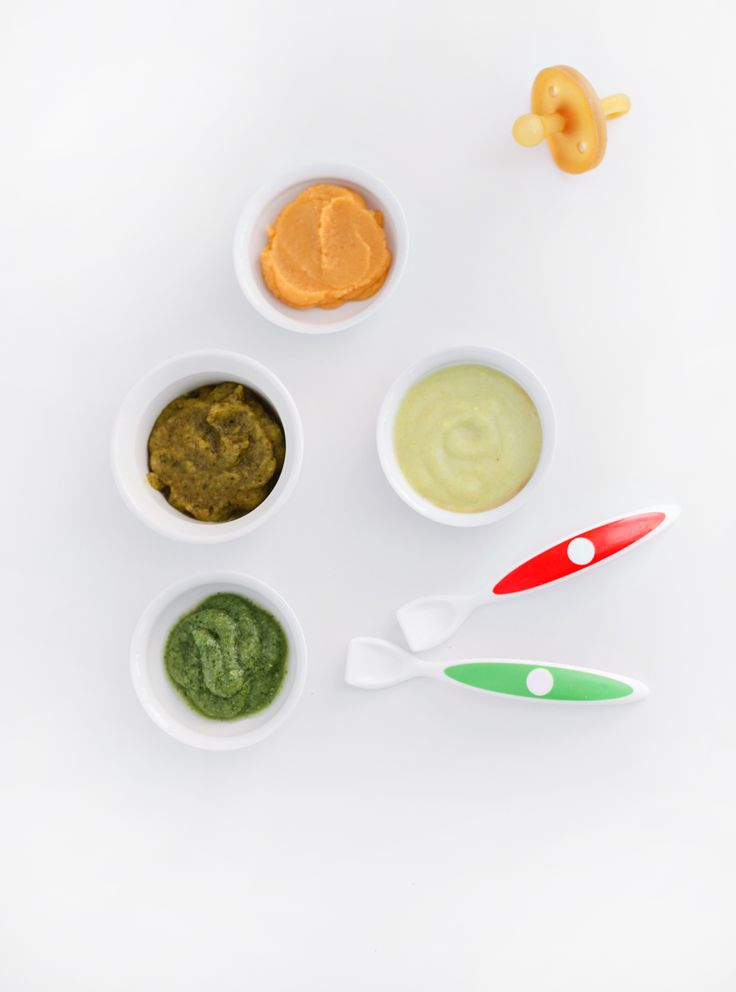
Just because it’s a nutrient-dense puree doesn’t mean your baby needs bowls upon bowls of it. Since beef puree has a somewhat intense flavor, a few spoonfuls added to your baby’s favorite veggie or fruit puree should be enough.
Is it your first time making homemade baby food? If you answered yes, then I suggest you start this journey by reading my in-depth Guide on How to Make Homemade Baby Food. The detailed article goes over all the essential information such as the best cooking tools to have on hand, safe storage, knowing when your baby is ready for solids, introducing purees, making the best first foods for baby, and more! You can also check out my best-selling cookbook for even more information and recipes.
Beef Puree Video
Watch this video to see how easy it is to make your baby homemade Beef Puree!
Reasons to Love this Beef Puree- simple yet flavorful
- packed with protein
- great to add to any other fruit or veggie puree that baby loves
- baby food for 4-6 months and up
- stage 1 baby food
- freezer-friendly
- homemade
Make sure to read the recipe card below for full ingredients and instructions!
- Beef: Since beef is the star of the show in this puree, we are going to start with a good piece of meat.
 We are going to use 8oz of chuck stew meat or cubed sirloin beef. You can also easily scale up this recipe if you want more than 12 ounces of baby food.
We are going to use 8oz of chuck stew meat or cubed sirloin beef. You can also easily scale up this recipe if you want more than 12 ounces of baby food. - Broth: To get that rich, deep beef flavor, we will cook our beef in beef broth. I recommend using a low-sodium, sodium-free, or free-range beef bone broth for this recipe. You can also use any of those variations above with a vegetable broth as well. If you don’t have any of those on hand, you can use water.
- Oregano: We are adding dried oregano to give the puree a little more complex taste. This can easily be omitted if you prefer or you can substitute in dried parsley, basil, rosemary, thyme or cilantro.
Grass-Fed Beef: I recommend using grass-fed beef for this recipe, if possible. Grass-fed beef will have more healthy fats, more free Omega-3 fatty acids (healthy fats), vitamins A, E, and B as well as more antioxidants.
Health Benefits of Beef
- Protein: Beef is an excellent source of protein, which is essential for proper growth and development of all organ systems and maintaining and repairing tissues.
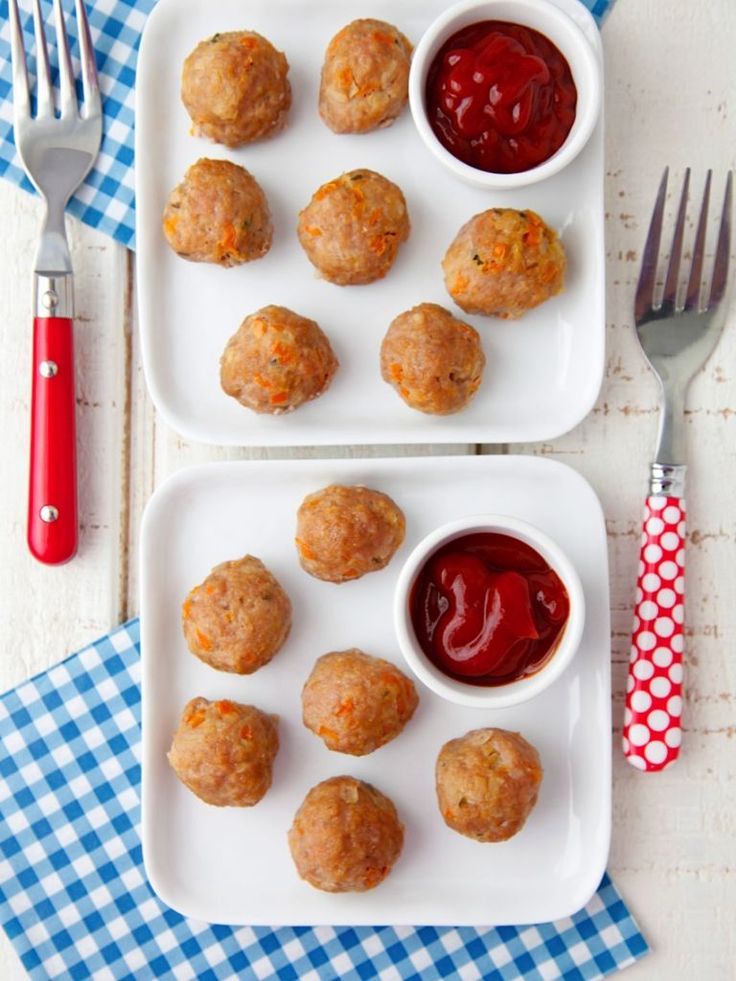 It is considered a complete protein, meaning it has all of the amino acids that are needed to make protein.
It is considered a complete protein, meaning it has all of the amino acids that are needed to make protein. - Iron: Beef is a good source of iron, needed for making red blood cells, neurodevelopment and preventing iron deficiency anemia, and zinc, needed for growth and development and supporting the immune system.
- B12: Beef is also high in B12, which is essential for brain development and healthy red blood cells.
- Choline: can also be found in beef, which is also important for brain growth and development.
- Boil: In a medium saucepan, bring the cubed beef, broth, and oregano to a boil over medium heat.
- Simmer: Turn the heat down to low and cover the saucepan. Simmer for 15-20 minutes or until the beef is just cooked through. Let it cool slightly.
- Puree: Using a slotted spoon, transfer the beef to a blender or food processor and puree until you reach your desired consistency, adding broth in 1/4 cup increments if needed.
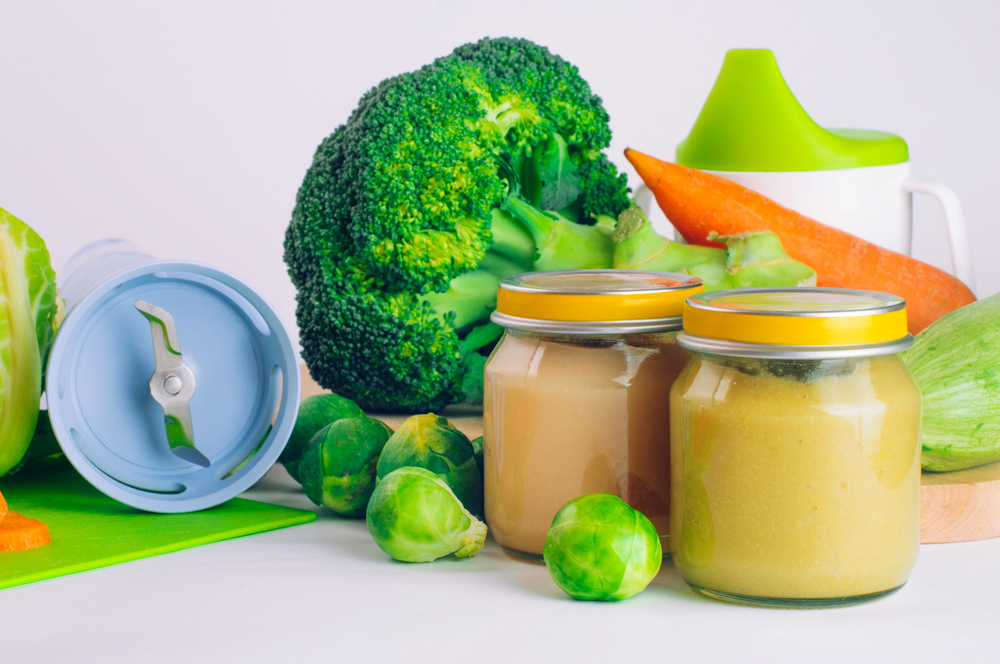
- Eat: Serve to your baby plain or added into another puree.
- Freeze: Store a small portion in the fridge and freeze the rest for another meal.
These tools will make it a lot easier for you to make this healthy Beef Puree. For more of my favorite kitchen tools make sure to check out my shop.
- Saucepans
- Blender or Food Processor
- Freezer Tray
- Storage Containers for Fridge
- Stasher Bag
- bib with catch pocket
- Saucepans
Frequently Asked Questions
When can baby eat beef puree?
Babies can have beef as one of their first foods. When a baby can start on solids is determined by their own rate of development, which generally comes between 4-6 months of age. Some of the developmental milestones babies need to reach in order to start solids include: if your baby has solid control of their head and neck, if your baby has doubled in weight, and if your baby is reaching for or opening their mouth when you eat (see my guide here). Before you start your baby on purees, you should consult with your pediatrician to make sure your child is developmentally ready.
Before you start your baby on purees, you should consult with your pediatrician to make sure your child is developmentally ready.
Can beef be baby’s first food?
Yes, beef can 100% be baby’s first food if you want it to be. It is recommended to wait to introduce the top eight allergen foods to baby once a few other well tolerated foods have been introduced, but otherwise foods can be introduced in any order so choose whatever you are most excited for baby to have.
Is beef a common allergen for baby?
No, beef is not a common allergen, however, as with any food, start with a small portion and be aware of any signs that might be an allergic reaction after introducing it.
Does beef cause constipation for babies?
No, beef itself is not known to cause constipation in babies, however it won’t really help with constipation either since it lacks fiber. If baby is eating too much meat, it could replace fiber-rich foods, which could cause constipation.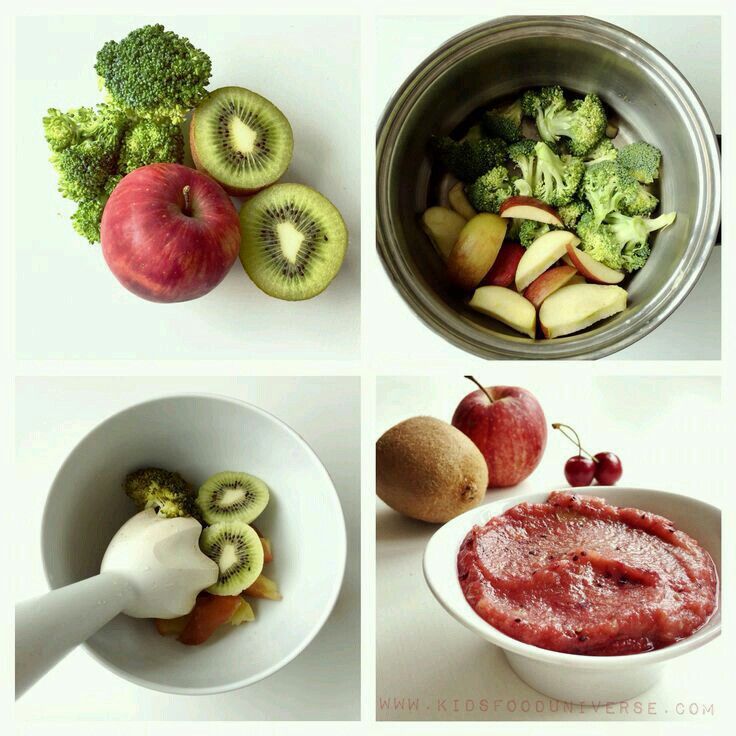
You can store this puree in an airtight container in the fridge for up to 3 days.
FreezerThis puree can be frozen for up to 2 months.
- Spoon puree into a freezer storage container. Do not overfill.
- Place the lid on the storage container or cover with a piece of saran wrap, and label with the date and recipe name.
- Place the tray into the freezer and let it freeze completely — preferably overnight.
- Pop out the baby food cubes and place them in a ziplock baggie or stasher bag. Don’t forget to relabel the baggie or stasher bag for future reference.
Need more information on how to store your baby foods? Head over to my Best Baby Food Storage Containers – Plus 6 Tips on Freezing and Thawing post!
Label Tip: Don’t forget to label your purees before you place them in the fridge or freezer with the name of the puree and the date you made it.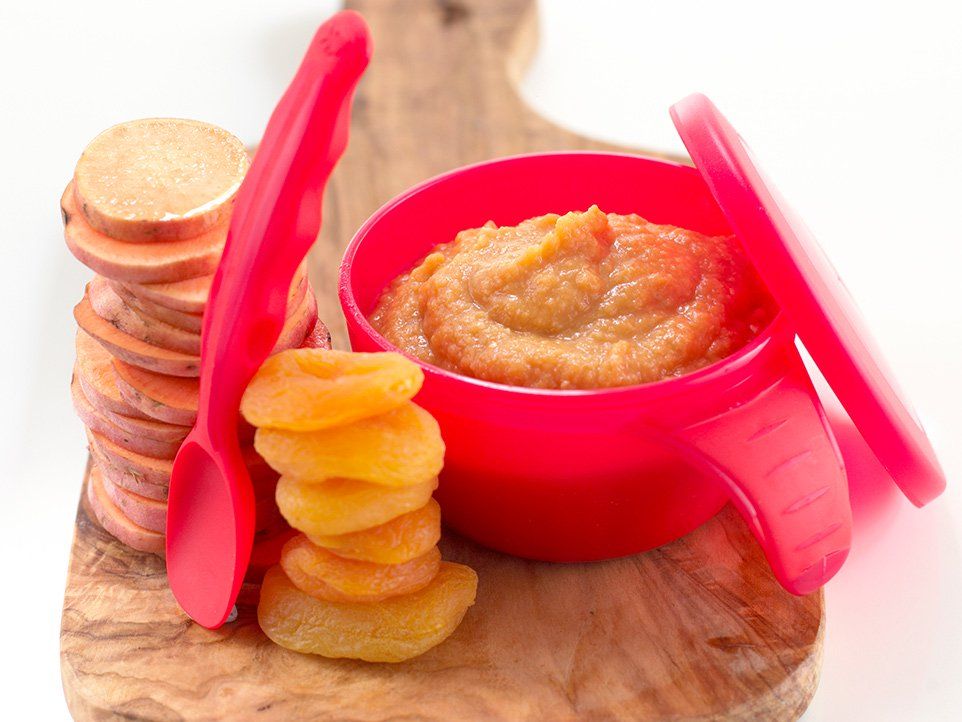 Take it from me; by the end of the week, you will completely forget what is in your freezer and how long it’s been there. 😉
Take it from me; by the end of the week, you will completely forget what is in your freezer and how long it’s been there. 😉
While this beef baby food is great by itself, it can be a little intense for some babies. I recommend mixing it into one of your baby’s favorite purees as an introduction to the rich taste of beef. Here are some great purees to mix with the beef puree:
- Apples
- Sweet Potato
- Pear
- Carrot
- Broccoli
- Pea
- Mango
PUREE FEEDING TIPS
- Follow your baby’s lead – when feeding purees from a spoon, sometimes there’s a tendency to keep offering bites past the point of your baby being full. Always follow your baby’s cues for when they are done eating. Turning away from the spoon, closing her mouth, or pushing food away are all signs that your baby is finished with the meal.
- Try adding a little seasoning or spice to purees – babies like flavor! Or consider changing the temperature of purees from time to time, to slightly warmed or slightly chilled.
 Varying these aspects adds to the sensory experience!
Varying these aspects adds to the sensory experience! - Throwing spoons is a common phase that all babies go through at one point or another. One of the best ways to handle spoon throwing is to ignore it and keep feeding your baby as usual (with an extra spoon you already have at the table). If your baby ends up also throwing back up spoons #2 AND #3, simply encourage your baby to eat with their hands until they appear to be finished with the meal. ***Give baby plenty of opportunities to practice putting items in and taking items out of containers outside of mealtimes.
- Use a Slotted Spoon: When transferring the cooked beef from the saucepan to the blender, make sure to use a slotted spoon so you don’t add too much broth into the puree from the start. You only want to add broth if needed while blending. I had to add a 1/4 cup of broth to the blender while I was pureeing this beef.
- Reheat Gently: If you are freezing some of this beef puree, reheat it in 20-second intervals.
 You don’t want to recook the beef.
You don’t want to recook the beef.
- 8 ounce beef chuck stew meat, or cubed sirloin beef
- 2 cups beef or vegetable broth, low or no sodium
- 1 tsp dried oregano
Boil: In a medium saucepan, bring beef, broth and oregano to a boil over medium heat. Turn to low and simmer for 15-20 minutes or until beef is cooked all the way through. Let cool slightly.
Transfer: Using a slotted spoon, transfer the beef to a blender or food processor, reserve broth.
Puree: starting on low and working your way up to high-speed, puree the beef until you reach your desired consistency, adding in broth in 1/4 cup increments if needed.
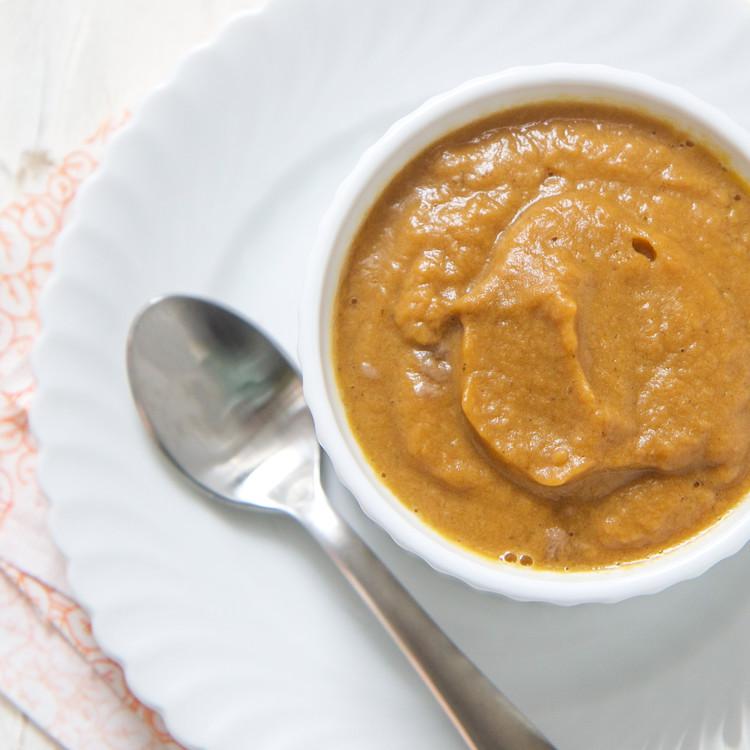 I had to add in just 1/4 cup of broth to get the consistency seen in this photo.
I had to add in just 1/4 cup of broth to get the consistency seen in this photo.Eat: serve to baby plain or added into another puree.
Freeze: store a small portion in the fridge and freeze the rest for another meal.
Age: 4-6 months and up
Yield: 12 ounces
Storage: Fridge – store in an airtight container in the fridge for up to 4 days or in the freezer for up to 4 months.
Saucepan
Blender
Bumkins Baby Bowl
Freezer Tray
Did you make this recipe?
Tag @babyfoode on Instagram and hashtag it #babyfoode!
Pin Recipe Email a Friend
Meat complementary foods in the nutrition of children of the first year of life | #04/09
Meat is an important component of baby food, as it is a source of protein and essential amino acids that a child needs for normal growth and development. Also an important characteristic of this product is the presence in it of a sufficient level of heme iron, which is characterized by a high degree of bioavailability. This is especially true for children in the second half of life, since by this period the iron reserve is depleted. In this regard, obtaining iron with food (complementary foods) becomes extremely necessary [1, 2]. Separately, the role of meat complementary foods as a source of zinc, a mineral substance that performs a number of important functions in the body, should be emphasized. Insufficient intake of this mineral adversely affects the processes of growth and development, is accompanied by a violation of immunological reactivity, etc. It is known that by 4-6 months of age, children who are, for example, exclusively breastfed, become vulnerable to deficiency of not only iron, but also zinc [3]. In addition, meat contains a number of other minerals - salts of phosphorus, potassium, magnesium, as well as B vitamins - B12, B1, B2, B6.
Also an important characteristic of this product is the presence in it of a sufficient level of heme iron, which is characterized by a high degree of bioavailability. This is especially true for children in the second half of life, since by this period the iron reserve is depleted. In this regard, obtaining iron with food (complementary foods) becomes extremely necessary [1, 2]. Separately, the role of meat complementary foods as a source of zinc, a mineral substance that performs a number of important functions in the body, should be emphasized. Insufficient intake of this mineral adversely affects the processes of growth and development, is accompanied by a violation of immunological reactivity, etc. It is known that by 4-6 months of age, children who are, for example, exclusively breastfed, become vulnerable to deficiency of not only iron, but also zinc [3]. In addition, meat contains a number of other minerals - salts of phosphorus, potassium, magnesium, as well as B vitamins - B12, B1, B2, B6.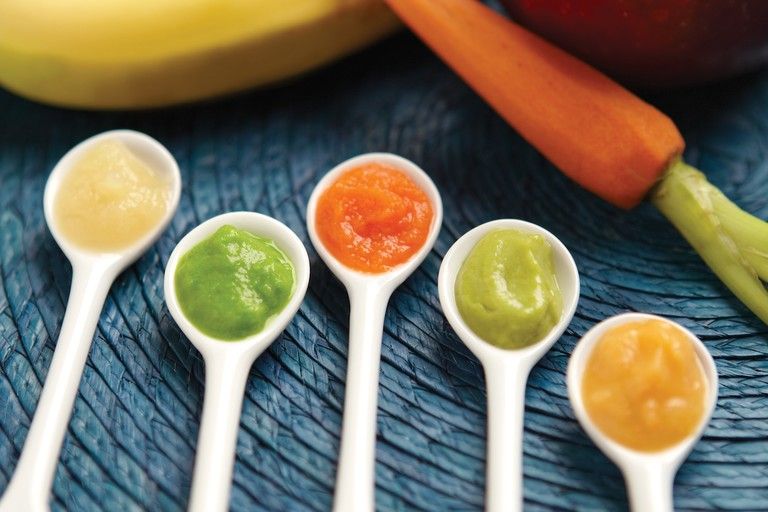
According to the latest changes to optimize the nutrition of children of the first year of life, reflected in the draft National Program, meat complementary foods are recommended for children of the first year of life no later than 6 months of life. At the same time, meat puree is a dish introduced into the child's diet after grain complementary foods (porridge) and vegetable puree. At the same time, it should be noted that in a number of foreign studies, meat complementary foods are preferred as the first product. This is mainly due to the high bioavailability of iron and zinc from this product. According to these studies, the assimilation of zinc and iron from a meat product and the subsequent physical development of children who received meat puree as the first complementary food is much better in comparison with children who traditionally received commercially produced cereals (fortified with zinc and iron) [4, 5] .
In the nutrition of infants, it is advisable to use canned meat of industrial production, for the preparation of which meat of the highest grades (beef, horse meat, pork, poultry), as well as offal, is used.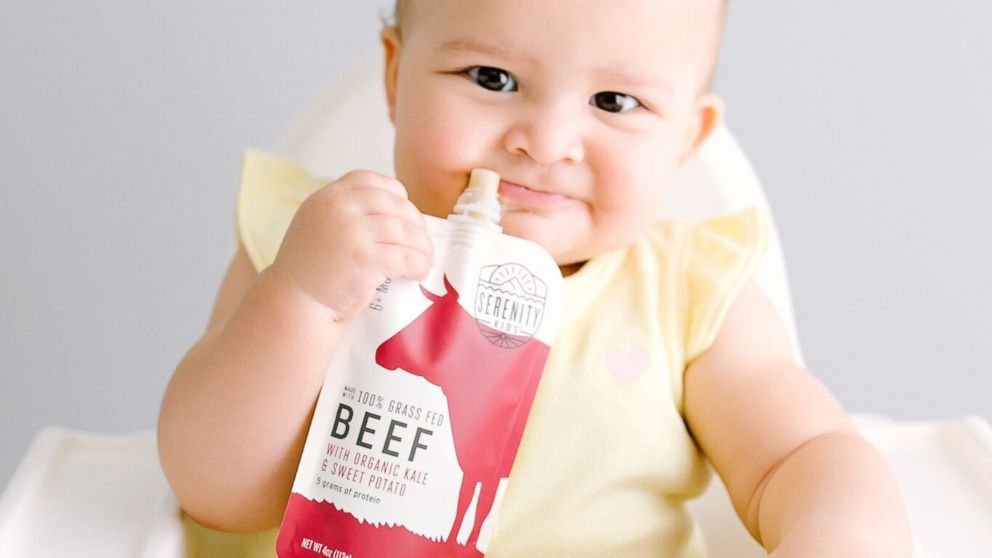 It should be noted that mashed potatoes from beef, pork, chicken, turkey, etc. can be recommended from 6 months, mashed potatoes with the inclusion of offal - from 8 months [6]. At the same time, the recommended amount of meat puree gradually increases from 30 g to 50 g - by 8 months and up to 60–70 g per day - by 9 months.months
It should be noted that mashed potatoes from beef, pork, chicken, turkey, etc. can be recommended from 6 months, mashed potatoes with the inclusion of offal - from 8 months [6]. At the same time, the recommended amount of meat puree gradually increases from 30 g to 50 g - by 8 months and up to 60–70 g per day - by 9 months.months
According to the modern classification in force in Russia, complementary foods that are a source of meat are divided into groups:
-
meat based;
-
plant-based with the addition of meat;
-
meat based.
The composition of canned food “vegetable-based with meat” and “meat-and-vegetable based”, in addition to meat, includes various vegetables (zucchini, potatoes, pumpkin, cauliflower, broccoli, etc.), cereals (rice, oatmeal, buckwheat, semolina groats). This improves the taste of the product and allows you to diversify the diet of the child.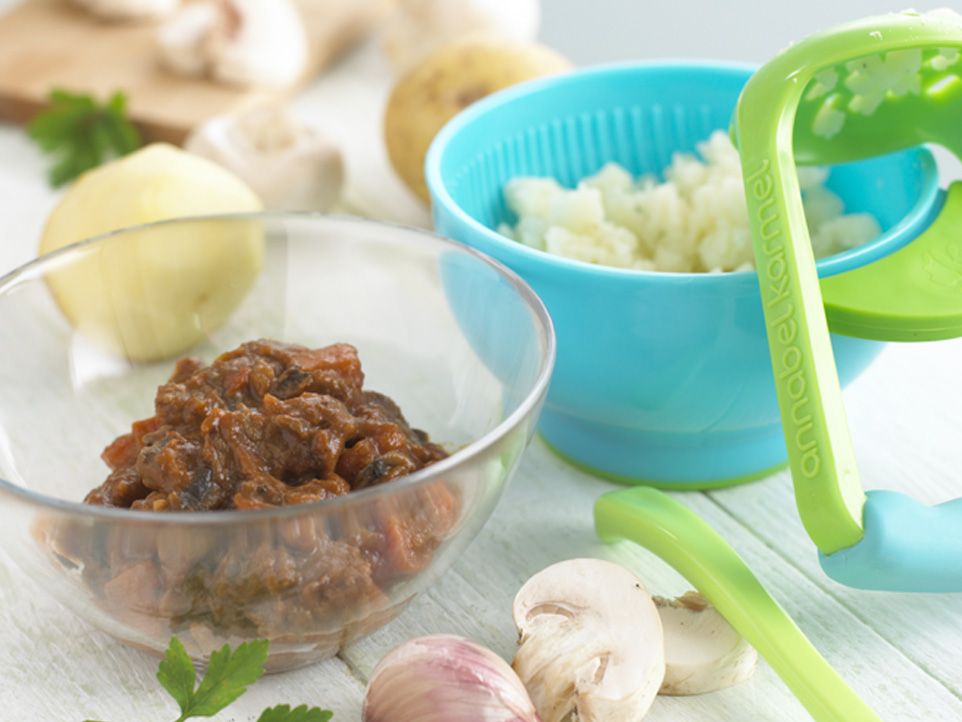
A mono-component product should be used as the first meat puree. Meat puree with the addition of dill and cumin is recommended for use from 6–7 months. Multicomponent meat purees, which include onion, garlic, legumes, celery, parsley, are used in the nutrition of children older than 8 months. After 9 months, spices (sweet and white pepper, bay leaf) can be included in the puree, after 10 months - basil, coriander, allspice.
Separately, I would like to dwell on the characteristics of canned meat for children with offal. Of course, the introduction of meat purees with offal into the diet allows the child to be provided with minerals such as copper and manganese, the content of which in these products is higher than in complementary meat products without including the liver, heart, and tongue. However, the high content of extractives, cholesterol, etc. in by-products indicates the need for a later appointment of this type of complementary foods in a limited amount.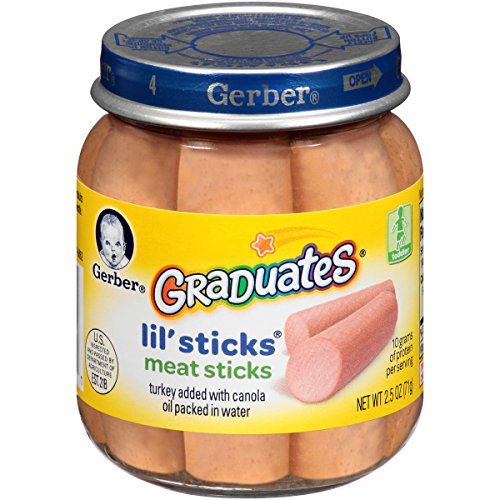
Starch and (or) cereals can be used to give the puree a delicate texture. Also, butter or vegetable oil, iodized salt in minimal quantities can be added to canned food. Taking into account the age characteristics of the child's gastrointestinal tract, it is planned to produce canned food of various degrees of grinding: homogenized (for children 6–7 months old), pureed (for children 7–8 months old), coarsely ground (for children 9–12 months old) [7].
At present, not only foreign ones (Gerber, Heinz, Beech-Nat, Samper, HiPP, Kolinska, Nestle, Nutricia, etc.), but also domestic manufacturers have developed special canned meat for children (OJSC Progress (FrutoNyanya), First Baby Food Plant, MK Tikhoretsky (Tyoma), OJSC Wimm-Bill-Dann Foods (Agusha), LLC Sivma (Babushkino lukoshko), etc.). A large assortment of commercially produced meat complementary foods, currently on the Russian market, allows you to individualize nutrition, taking into account the age of the child and his state of health.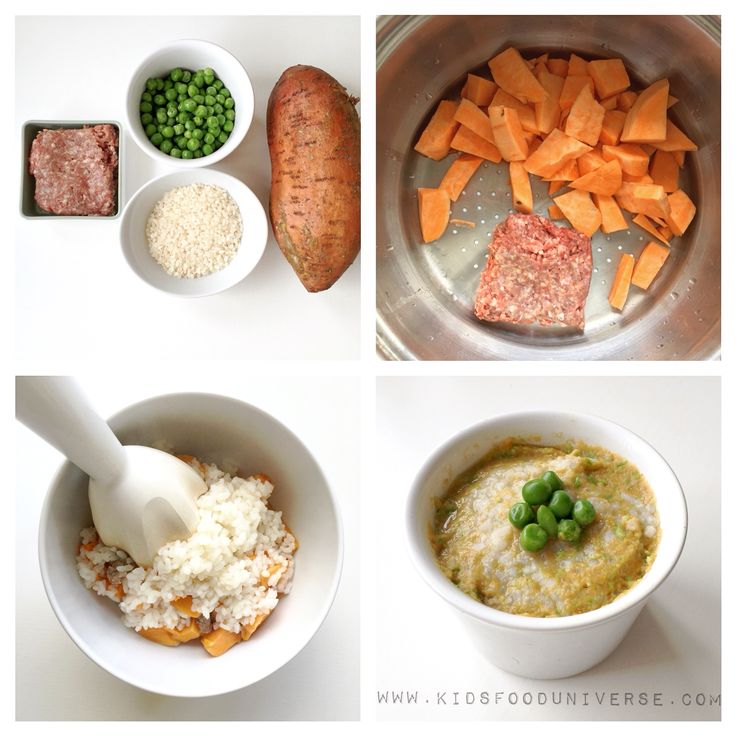 For example, in the case of a aggravated allergic history, it is recommended to use canned meat for children made from hypoallergenic meats - pork, turkey, horse meat, etc. In this case, the presence of various shaping agents in the product - corn, rice starch, etc., should be taken into account, since their presence can induce the development of an allergic reaction. Therefore, the content of these thickeners in the product should be kept to a minimum.
For example, in the case of a aggravated allergic history, it is recommended to use canned meat for children made from hypoallergenic meats - pork, turkey, horse meat, etc. In this case, the presence of various shaping agents in the product - corn, rice starch, etc., should be taken into account, since their presence can induce the development of an allergic reaction. Therefore, the content of these thickeners in the product should be kept to a minimum.
So, for example, children suffering from food allergies can be recommended children's canned meat domestic production FrutoNyanya, made from pork, turkey, rabbit, lamb. These products are made with a minimum amount of shapers (no more than 2% corn starch), without the addition of broth, salt, spices, soy protein, bone meal. As for nutritional value, the protein content in these products is at least 14–16 g per 100 grams of the product.
Quite new products for the Russian market are ready-made complementary foods - children's soups (dry instant and homogenized canned food) on vegetable and vegetable-meat. These products have a liquid consistency and are diluted with water during cooking. Children's soups can be used both as complementary foods in children of the first year of life, and in the nutrition of older babies. An example of such products can be children's soups produced by Heinz.
These products have a liquid consistency and are diluted with water during cooking. Children's soups can be used both as complementary foods in children of the first year of life, and in the nutrition of older babies. An example of such products can be children's soups produced by Heinz.
Thus, the modern assortment of industrial canned meat for children is characterized by an optimal composition, which makes it possible to provide the child's body with such important components as protein, iron, zinc, etc. In addition, a wide selection of these products allows an individual choice of a product based on the characteristics of the condition child's health.
Literature
-
Domellof M., Cohen R. J., Dewey K. G. et al. Iron supplementation of breast-fed Honduran and Swedish infants from 4 to 9months of age // J Pediatr. 2001; 138:679–687.
-
American Academy of Pediatrics. Committee on Nutrition.
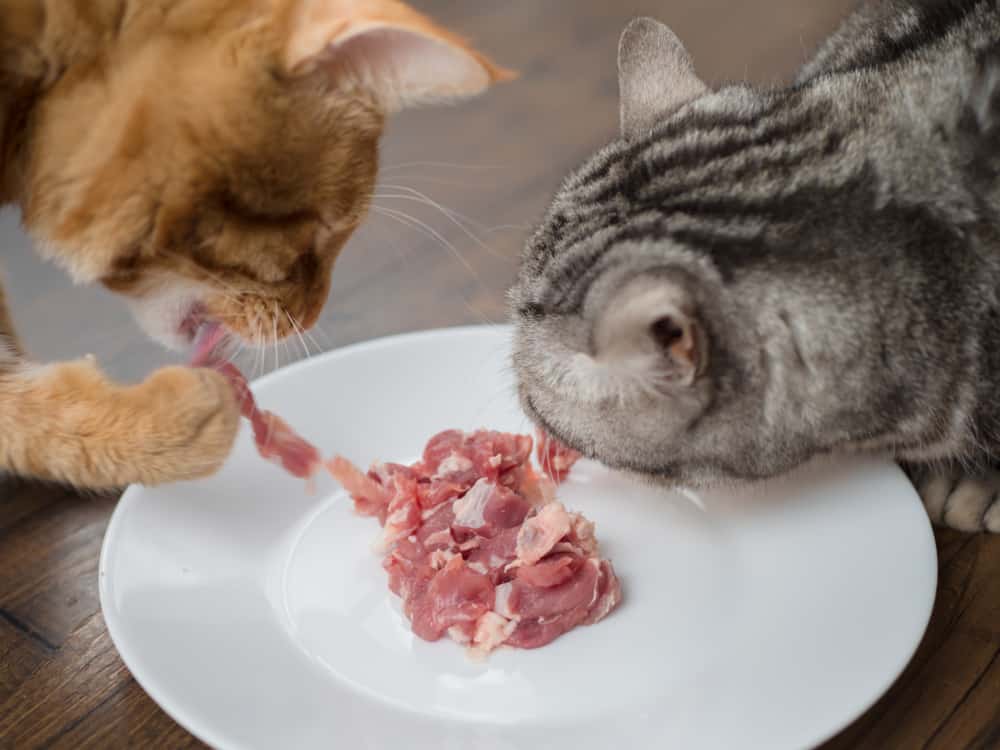 The use of whole cow's milk in infancy // Pediatrics. 1992; 89:1105–1109.
The use of whole cow's milk in infancy // Pediatrics. 1992; 89:1105–1109. -
Dewey K. G. Nutrition, growth, and complementary feeding of the breastfed infant // Pediatr Clin North Am. 2001 Vol. 48, No. 1. P. 87–104.
-
Krebs N. F., Westcott J. E., Butler N. et al. Meat as a first complementary food for breastfed infants: feasibility and impact on zinc intake and status // J Pediatr Gastroenterol Nutr. 2006; 42(2): 207–214.
-
Krebs N. F. Meat as an early complementary food for infants: implications for macro- and micronutrient intakes // Nestle Nutr Workshop Ser Pediatr Program. 2007; 60:221–229.
-
Sanitary and epidemiological rules and regulations SanPin 2.3.2. 1940–05
-
Children's Nutrition Guide. Edited by Tutelyan V.A., Konya I.Ya. M.: Medical Information Agency, 2004. 662 p.
E. A. Gordeeva , Candidate of Medical Sciences RMAPE , Moscow
Meat products for healthy nutrition of children
Home / Meat and poultry / Meat products for nutrition of children
11/25/2016
Product. BY No. 9 (173) September 2016
BY No. 9 (173) September 2016
Meat and poultry
BELTRUMF LLC
Children's picky eating habits are a problem faced by many parents. Children prefer to eat the same foods. Why does the child not allow the slightest variety in food, and what to do about it? After all, a varied diet is necessary for a child to grow healthy. The fact is that young children are extremely conservative. They strive for stability and peace, they are afraid of everything new, unexpected, unfamiliar. Children try to make their whole life monotonous, starting from the daily routine and ending with the list of dishes for breakfast, lunch and dinner. It happens that a child rejects food for another reason - he wants to be quite independent, to prove that he does not depend on you and can choose his own food. This is a kind of protest sign. There is no need to fight the baby, force him to eat the food that you consider useful and necessary for him. Do not try to be more stubborn than the baby, rather let him make his own choice.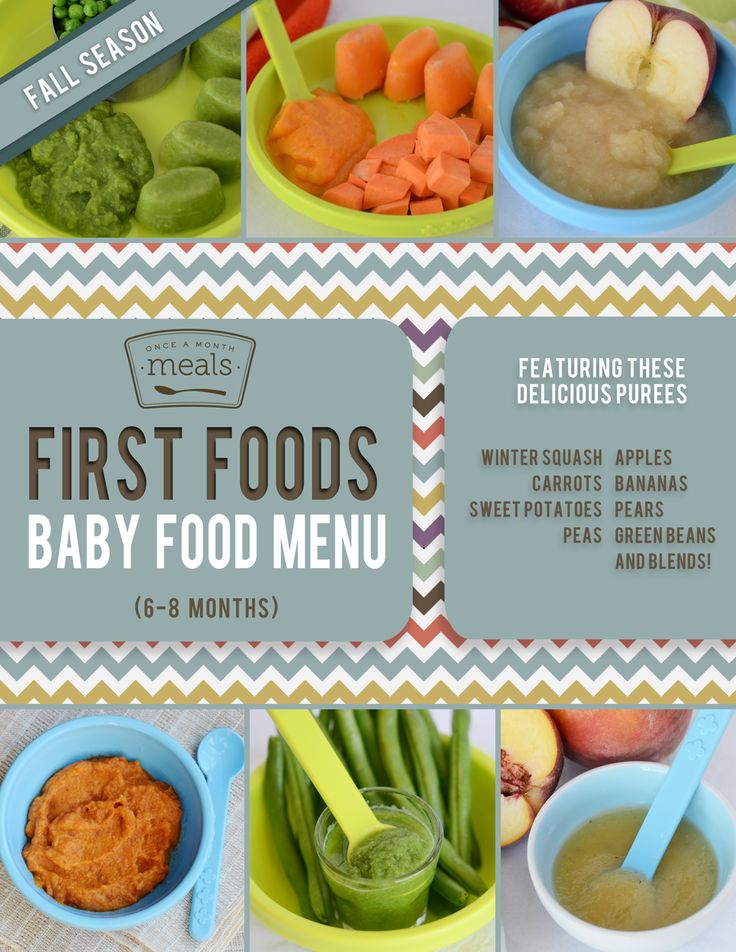
Meat must be used in children's nutrition as the main source of complete, almost 100% well-digestible protein, rich in essential amino acids, which, in turn, are necessary for the full growth and development of the child. In addition, meat is a significant source of fat, B vitamins, minerals, phosphorus, potassium, zinc, and easily digestible iron.
Cooked sausage products according to STB 2247-2012 for feeding children of preschool and school age, in addition to traditional raw materials - beef, pork, veal, poultry meat - can be made from rabbit meat. In the nutrition of children, it is recommended to use meat that contains the least amount of connective tissue, tendons and fascia. The most valuable proteins, such as myosin and myogen, are found in muscle tissue. Their amino acid composition is close to that of human tissue proteins. There are few essential amino acids in the proteins contained in connective tissue, collagen and elastin (incomplete proteins). Elastin is a connective tissue substance that is resistant to heat treatment and is not broken down by pepsin, so it is practically not absorbed by the body.
Elastin is a connective tissue substance that is resistant to heat treatment and is not broken down by pepsin, so it is practically not absorbed by the body.
Rabbit meat is considered dietary. It contains 21% protein and 7-16% fat, very little connective tissue and cholesterol, and quite a lot of iron. Rabbit muscle fibers have a finer structure, which contributes to their good digestion and absorption by the body. Rabbit meat protein does not cause allergic reactions, therefore this meat belongs to low allergenicity products.
In the diet of children, along with animal meat, chicken and turkey meat can be used. The meat of ducks and geese is very fatty, it has a lot of connective tissue, so it is better not to use it in baby food. In addition to the full-fledged amino acid composition of chicken and turkey proteins, the fat composition of this meat deserves attention. It contains quite a lot of essential polyunsaturated fatty acids, several times more than in beef. Poultry meat is rich in B vitamins, phosphorus, iron, zinc.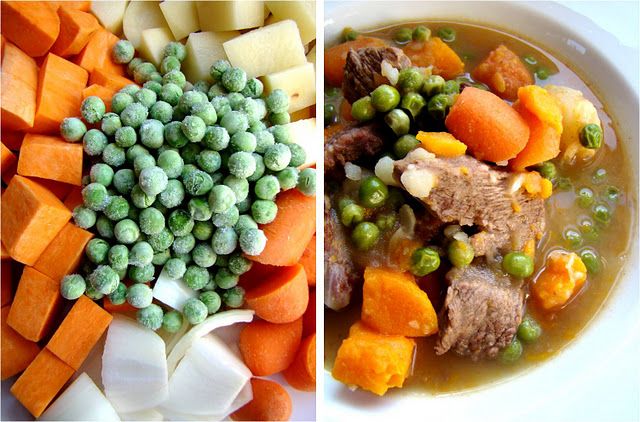 This meat contains little connective tissue, so it is soft and well digested and absorbed by the body.
This meat contains little connective tissue, so it is soft and well digested and absorbed by the body.
Veal is more preferable in baby food than beef because it contains less connective fibers and, therefore, it takes less time to cook, retains more vitamins, and is easier to digest.
In the manufacture of boiled sausages, offal, such as tongue, heart, liver, can also be added to them. It is not allowed to use the meat of bulls, boars, lean animals, meat frozen more than once, genetically modified raw materials. It is allowed to use food additives that do not contain phosphates, hot spices, preservatives, flavor and aroma enhancers, artificial flavors and dyes.
LLC "Beltrumf" successfully sells complex food additives "Sausages Kolobok PF maxi FBEA-07836", "Sausages for children PF maxi FBEA-07838", "Sausages Lakomka PF maxi FBEA-07837", intended for the production of boiled sausage products for children's nutrition preschool and school age.
TRUMF International and Beltrumf LLC create innovative technologies for new types of meat-based products for feeding children of various age groups; develop regulatory and technical documentation, taking into account the raw material base, the availability of equipment and production capacities; provide consulting assistance in organizing production on existing or new equipment; provide documentation support at the stage of product declaration. The team of Beltrumf LLC has many years of experience in creating, developing and implementing meat-based baby food technologies for children of various age groups. Products are developed on the basis of comprehensive research, taking into account the physiological characteristics and needs of the body. Composite and quantitative compositions of complex food additives are being developed. The selection of vitamins, minerals and biologically active components in the composition of complex food additives is carried out, designed to enrich the meat products of baby food, taking into account the age-related metabolic processes of the body and the physiological norms of needs for basic nutrients. At the stage of mastering the production of baby food meat products and introducing new types, the company's specialists conduct a tasting assessment of samples for compliance with the requirements of regulatory and technical documentation for organoleptic characteristics. Employees have the necessary information about the possibility of using certain ingredients in the composition of complex food additives for feeding children of various age groups, and also have experience working with companies and enterprises that produce complex additives for enriching baby food.
The team of Beltrumf LLC has many years of experience in creating, developing and implementing meat-based baby food technologies for children of various age groups. Products are developed on the basis of comprehensive research, taking into account the physiological characteristics and needs of the body. Composite and quantitative compositions of complex food additives are being developed. The selection of vitamins, minerals and biologically active components in the composition of complex food additives is carried out, designed to enrich the meat products of baby food, taking into account the age-related metabolic processes of the body and the physiological norms of needs for basic nutrients. At the stage of mastering the production of baby food meat products and introducing new types, the company's specialists conduct a tasting assessment of samples for compliance with the requirements of regulatory and technical documentation for organoleptic characteristics. Employees have the necessary information about the possibility of using certain ingredients in the composition of complex food additives for feeding children of various age groups, and also have experience working with companies and enterprises that produce complex additives for enriching baby food.









